Assessing the State of Structural Foundations in Permafrost Regions by Means of Acoustic Testing
Abstract
:1. Introduction
2. Methodology. Problem Statement
2.1. Soil Model Selection
- When condition monitoring a permafrost foundation, it is necessary to monitor not only changes in the deformation characteristics of the foundation, but also in the forces that interact within the pile–soil system.
- In order to use DTP as the foundation of a model for monitoring permafrost foundations, it is necessary to monitor on site changes in = , , .
2.2. Methods for Finding Soil Parameters
2.3. Problem Statement
- To study the possibility of finding during the thawing of soils by means of acoustic testing using the relationship = f (E) found for the frozen state.
- To study the relationship on disturbed samples of frozen sand.
3. Materials and Methods
- The soil was dried in an oven at a temperature of 100 °C for four hours;
- The soil was sieved to remove coarse parts;
- The soil was moisturized by weight;
- The soil was put in moulds and the samples were weighed;
- The samples was compacted to the required density;
- The samples were left to freeze for 24 h.
4. Results
5. Discussion
6. Conclusions
- Using the deformation theory of plasticity makes it possible to factor in the relationship between the deformation modulus and the maximum principal stress.
- Changes in and in the pile-soil system that occur when the soil thaws lead to a change in the resulting load P that is transferred by the structure to the foundation. Taking into account the change in P when condition monitoring of a permafrost foundation allows us to find the correct values of the deformation modulus and the parameters of stress–strain behaviour in the foundation.
- Using the correlation = f (E) established by means of RP tests and acoustic tests makes it possible to monitor the health of permafrost foundations, based on the results of acoustic testing, and prevents soils from demonstrating such properties as hysteresis and hardening/softening.
- The experiments we conducted to study the correlations = f (E) and showed that these parameters of frozen soils greatly depend on each other, and this dependency can be observed in both frozen and thawing soils. The results enabled us to make tentative conclusions about whether it is possible to use the proposed approach in order to solve the problems of condition monitoring of permafrost foundations. The test results formed the basis of a method that is being developed for condition monitoring of permafrost foundations in buildings and structures.
Author Contributions
Funding
Data Availability Statement
Conflicts of Interest
References
- Shiryaev, A.G.; Moiseev, P.A.; Peintner, U.; Devi, N.M.; Kukarskih, V.V.; Elsakov, V.V. Arctic Greening Caused by Warming Contributes to Compositional Changes of Mycobiota at the Polar Urals. Forests 2019, 10, 1112. [Google Scholar] [CrossRef] [Green Version]
- Desyatkin, A.; Fedorov, P.; Filippov, N.; Desyatkin, R. Climate Change and Its Influence on the Active Layer Depth in Central Yakutia. Land 2021, 10, 3. [Google Scholar] [CrossRef]
- Gendler, S.; Prokhorova, E. Risk-Based Methodology for Determining Priority Directions for Improving Occupational Safety in the Mining Industry of the Arctic Zone. Resources 2021, 10, 20. [Google Scholar] [CrossRef]
- Litvinenko, V.S.; Dvoynikov, M.V.; Trushko, V.L. Elaboration of a conceptual solution for the development of the Artic shelf from seasonally flooded coastal areas. Int. J. Min. Sci. Technol. 2021, 32, 113–119. [Google Scholar] [CrossRef]
- Vasiliev, G.G.; Dzhaljabov, A.A.; Leonovich, I.A. Analysis of the causes of engineering structures deformations at gas industry facilities in the permafrost zone. J. Min. Inst. 2021, 249, 377. [Google Scholar] [CrossRef]
- He, R.; Jin, H. Permafrost and cold-region environmental problems of the oil product pipeline from Golmud to Lhasa on the Qinghai-Tibet Plateau and their mitigation. Cold Reg. Sci. Technol. 2010, 64, 279. [Google Scholar] [CrossRef]
- Glotov, E.G.; Chlachula, J.; Glotova, L.P.; Little, E. Causes and environmental impact of the gold-tailings dam failure at Karamken, the Russian Far East. Eng. Geol. 2018, 245, 236. [Google Scholar] [CrossRef]
- Konstantinov, P.; Zhelezniak, M.; Basharin, N.; Misailov, I.; Andreeva, V. Establishment of Permafrost Thermal Monitoring Sites in East Siberia. Land 2020, 9, 476. [Google Scholar] [CrossRef]
- Badmaev, N.; Bazarov, A. Monitoring Network for Atmospheric and Soil Parameters Measurements in Permafrost Area of Buryatia, Russian Federation. Geosciences 2019, 9, 6. [Google Scholar] [CrossRef] [Green Version]
- Cao, H.; Gao, B.; Gong, T.; Wang, B. Analyzing Changes in Frozen Soil in the Source Region of the Yellow River Using the MODIS Land Surface Temperature Products. Remote Sens. 2021, 13, 180. [Google Scholar] [CrossRef]
- Batbaatar, J.; Gillespie, A.R.; Sletten, R.S.; Mushkin, A.; Amit, R.; Trombotto Liaudat, D.; Liu, L.; Petrie, G. Toward the Detection of Permafrost Using Land-Surface Temperature Mapping. Remote Sens. 2020, 12, 695. [Google Scholar] [CrossRef] [Green Version]
- Park, K.; Yang, H.; Lee, B.Y.; Kim, D. Development of Shallow-Depth Soil Temperature Estimation Model Based on Thermal Response in Permafrost Area. Appl. Sci. 2018, 8, 1886. [Google Scholar] [CrossRef] [Green Version]
- Liu, Z.; Yu, T.; Yan, N.; Gu, L. Variation of Ground Temperature along the Stratum Depth in Ice-rich Tundra of Hinggan Mountains Region, NE China. Geosciences 2020, 10, 104. [Google Scholar] [CrossRef] [Green Version]
- Cui, F.-Q.; Liu, Z.-Y.; Chen, J.-B.; Dong, Y.-H.; Jin, L.; Peng, H. Experimental Test and Prediction Model of Soil Thermal Conductivity in Permafrost Regions. Appl. Sci. 2020, 10, 2476. [Google Scholar] [CrossRef] [Green Version]
- Polyakov, V.; Nizamutdinov, T.; Abakumov, E.; Morgun, E. Soil Diversity and Key Functional Characteristics of Yakutsk City: Largest Urbanized Cryogenic World’s Ecosystem. Energies 2021, 14, 3819. [Google Scholar] [CrossRef]
- Lee, J.-S.; Yu, J.-D.; Han, K.; Kim, S.Y. Strength Characteristics of Sand–Silt Mixtures Subjected to Cyclic Freezing-Thawing-Repetitive Loading. Sensors 2020, 20, 5381. [Google Scholar] [CrossRef]
- Baltabaev, S.G.; Serebrykov, E.P.; Lebedev, M.S.; Lebedeva, E.T. Geotechnical monitoring of the Yamburg oil gas condensate field in the conditions of continuous distribution of permafrost soil. Eng. Surv. 2015, 1, 64. (In Russian) [Google Scholar]
- Burkov, D.V.; Gubaidullin, M.G. Geoekological monitoring of the Varanday coast-sea oil complex in Nenets autonomous region. Pet. Eng. 2010, 2, 21. (In Russian) [Google Scholar]
- Scaioni, M.; Marsella, M.; Crosetto, M.; Tornatore, V.; Wang, J. Geodetic and Remote-Sensing Sensors for Dam Deformation Monitoring. Sensors 2018, 18, 3682. [Google Scholar] [CrossRef] [Green Version]
- Ramirez, R.; Lee, S.-R.; Kwon, T.-H. Long-Term Remote Monitoring of Ground Deformation Using Sentinel-1 Interferometric Synthetic Aperture Radar (InSAR): Applications and Insights into Geotechnical Engineering Practices. Appl. Sci. 2020, 10, 7447. [Google Scholar] [CrossRef]
- Glinskikh, V.; Nechaev, O.; Mikhaylov, I.; Danilovskiy, K.; Olenchenko, V. Pulsed Electromagnetic Cross-Well Exploration for Monitoring Permafrost and Examining the Processes of Its Geocryological Changes. Geosciences 2021, 11, 60. [Google Scholar] [CrossRef]
- Sudakova, M.; Sadurtdinov, M.; Skvortsov, A.; Tsarev, A.; Malkova, G.; Molokitina, N.; Romanovsky, V. Using Ground Penetrating Radar for Permafrost Monitoring from 2015–2017 at CALM Sites in the Pechora River Delta. Remote Sens. 2021, 13, 3271. [Google Scholar] [CrossRef]
- Hauck, C. Geophysical Monitoring Techniques to Observe Alpine Permafrost Degradation---A 20-Years Perspective. In Proceedings of the EGU General Assembly 2019, Vienna, Austria, 7–12 April 2019. Document EGU2019-4195. [Google Scholar]
- Snegirev, A.M.; Velikin, S.A.; Istratov, V.A.; Kuchmin, A.O.; Skvortsov, A.G.; Frolov, A.D. Geophysical Monitoring in Permafrost Areas. In Proceedings of the 8th International Conference on Permafrost, Zürich, Switzerland, 21–25 July 2003; pp. 1079–1084. [Google Scholar]
- SP 25.13330.2020; Soil Bases and Foundations on Permafrost Soil. The Federal Agency for Technical Regulation and Metrology (Rosstandart): Moscow, Russia, 2021. (In Russian)
- GOST 27751-2014; Reliability for Constructions and Foundations. General Principles. The Federal Agency for Technical Regulation and Metrology (Rosstandart): Moscow, Russia, 2015. (In Russian)
- SP 22.13330.2016; Soil Bases of Buildings and Structures. The Federal Agency for Technical Regulation and Metrology (Rosstandart): Moscow, Russia, 2017. (In Russian)
- Mohsan, M.; Vardon, P.J.; Vossepoel, F.C. On the use of different constitutive models in data assimilation for slope stability. Comput. Geotech. 2021, 138, 104332. [Google Scholar] [CrossRef]
- Amouzou, G.Y.; Soulaïmani, A. Numerical Algorithms for Elastoplacity: Finite Elements Code Development and Implementation of the Mohr–Coulomb Law. Appl. Sci. 2021, 11, 4637. [Google Scholar] [CrossRef]
- Sukkarak, R.; Likitlersuang, S.; Jongpradist, P.; Jamsawang, P. Strength and stiffness parameters for hardening soil model of rockfill materials. Soils Found. 2021, 61, 1597. [Google Scholar] [CrossRef]
- Surarak, C.; Likitlersuang, S.; Wanatowski, D.; Balasubramaniam, A.; Oh, E.; Guan, H. Stiffness and strength parameters for hardening soil model of soft and stiff Bangkok clays. Soils Found. 2012, 52, 682. [Google Scholar] [CrossRef] [Green Version]
- Melnikov, R.; Zazulya, J.; Stepanov, M.; Ashikhmin, O.; Maltseva, T. OCR and POP parameters in Plaxis-based numerical analysis of loaded over consolidated soils. Procedia Eng. 2016, 165, 845. [Google Scholar] [CrossRef]
- Voznesensky, E.A.; Nikitin, M.S.; Sentsova, E.A. Methodic issues in determination of parameters for hardening soil models in small strain range. Geotechnics 2016, 2, 4. (In Russian) [Google Scholar]
- Mirnyy, A.Y.; Ter-Martirosyan, A.Z. Applications of modern mechanical soil models. Geotechnics 2017, 1, 20. (In Russian) [Google Scholar]
- Strokova, L. Determination of parameters for numerical modeling of soil behavior. N. Tomsk. Polytech. Univ. 2008, 313, 69. (In Russian) [Google Scholar]
- Kurguzov, K.V.; Fomenko, I.K. Constitutive mathematical soil models in geotechnical practice. Review. Nat. Tech. Sci. 2019, 5, 240–247. (In Russian) [Google Scholar] [CrossRef]
- Fadeev, A.B. Finite Element Method in Geomechanics; Shemyakin, E.I., Ed.; Nedra: Moskow, Russia, 1987; pp. 13–25. (In Russian) [Google Scholar]
- Boussinesq, M.J. Principalement au Calcul des Deformations et des Pressions. Gauthier-Villars. 1885. Available online: https://books.google.com.hk/books?hl=zh-CN&lr=&id=AK5YAAAAQAAJ&oi=fnd&pg=PA15&dq=Principalement+au+calcul+des+deformations+et+des+pressions.+&ots=dtDPIY3GI2&sig=ye617ICcjoCIaOZKKtzm29bMqXs&redir_esc=y&hl=zh-CN&sourceid=cndr#v=onepage&q=Principalement%20au%20calcul%20des%20deformations%20et%20des%20pressions.&f=false (accessed on 15 February 2022).
- Mindlin, R.; Cheng, D. Nuclei of strain in the semi-infinite solid. J. Appl. Phys. 1950, 21, 926. [Google Scholar] [CrossRef]
- Tsitovich, N.A. Soil Mechanics; Chercasova, I.I., Ed.; Hight School: Moscow, Russia, 1983; pp. 232–243. (In Russian) [Google Scholar]
- Vyalov, S.S. Reological Based Mechanic’s Soil; Hight School: Moscow, Russia, 1978; pp. 173–190. (In Russian) [Google Scholar]
- Karpenko, F.S.; Kalbergenov, R.G.; Kutergin, R.G.; Merzlyakov, V.P. Determination of Rheological properties of frozen soils by relaxation method. Soil Mech. Found. Eng. 2020, 57, 364. [Google Scholar] [CrossRef]
- GOST 20276.2-2020; Soils. Radial Pressuremeter Test Procedure. The Federal Agency for Technical Regulation and Metrology (Rosstandart): Moscow, Russia, 2021. (In Russian)
- Pronkevich, S.A.; Shpurgalova, M.Y. Models of soil and rocks in finite element modelling. Theor. Appl. Mech. Int. Sci. Tech. Collect. 2018, 33, 185. (In Russian) [Google Scholar]
- Mindel, I.G.; Sevostianova, V.V.; Trifonov, B.A.; Ragozin, N.A. The study of deformability and strength of fine-grained soils by seismoacoustic methods. Geoekologia Inzheneraya Geol. Gidrogeol. Geokriol. 2016, 5, 461. (In Russian) [Google Scholar]
- Gogolinskiy, K.V.; Syasko, V.A. Prospects and challenges of the fourth industrial revolution for instrument engineering and metrology in the field of non-destructive testing and condition monitoring. Insight-Non-Destr. Test. Cond. Monit. 2019, 61, 434. [Google Scholar] [CrossRef]
- Pioro, E.V.; Oshkin, A.N. Interrelations of acoustic characteristics and indicators of physical and deformation properties of soil. Vestn. Mosk. Univ. 2011, 6, 71–74. (In Russian) [Google Scholar]
- Abed, M.A. Indirect Evaluation of the compressive strength of recycled aggregate concrete at long ages and after exposure to freezing or elevated temperatures. Russ. J. Nondestruct. Test. 2021, 57, 195. [Google Scholar] [CrossRef]
- Erenson, C.; Kalkan, M. An investigation of the void structure of lightweight concrete containing waste undersize pumice additive using nondestructive methods. Russ. J. Nondestruct. Test. 2021, 57, 679. [Google Scholar] [CrossRef]
- GOST 17624-2012 Concrete; Ultrasonic Method of Strength Determination. The Federal Agency for Technical Regulation and Metrology (Rosstandart): Moscow, Russia, 2014. (In Russian)
- GOST 12248.8-2020 Soil; Determination of Characteristics of the Strength of Frozen Soils by Shearing on the Freezing Surface. The Federal Agency for Technical Regulation and Metrology (Rosstandart): Moscow, Russia, 2021. (In Russian)
- GOST 12248.9-2020 Soil; Determination of Creep Properties of Frozen Soils by Uniaxial Compression Test. The Federal Agency for Technical Regulation and Metrology (Rosstandart): Moscow, Russia, 2021. (In Russian)
- GOST 34028-2016; Reinforcing Rolled Products for Reinforced Concrete Constructions. Specifications. The Federal Agency for Technical Regulation and Metrology (Rosstandart): Moscow, Russia, 2019. (In Russian)
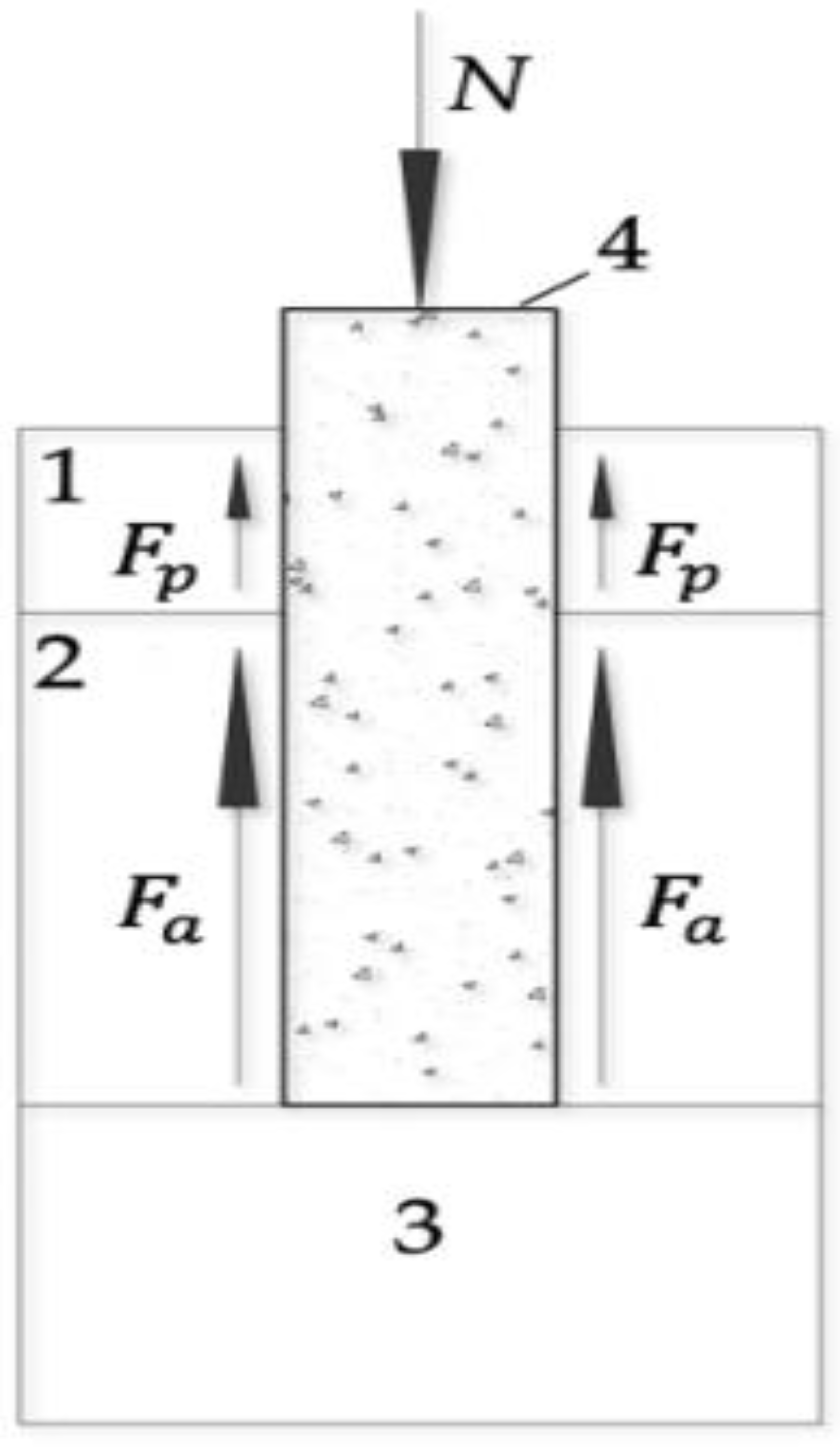
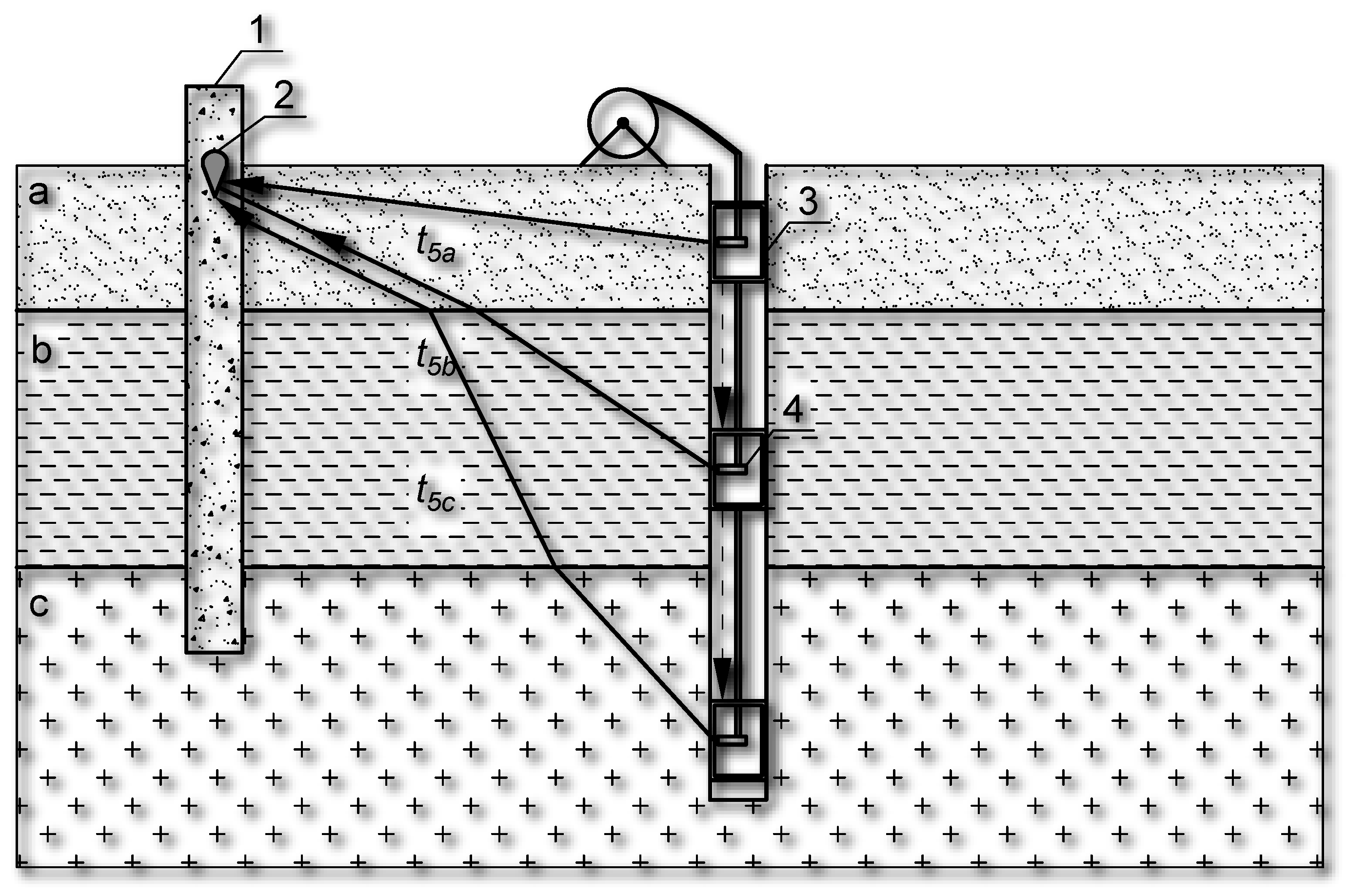
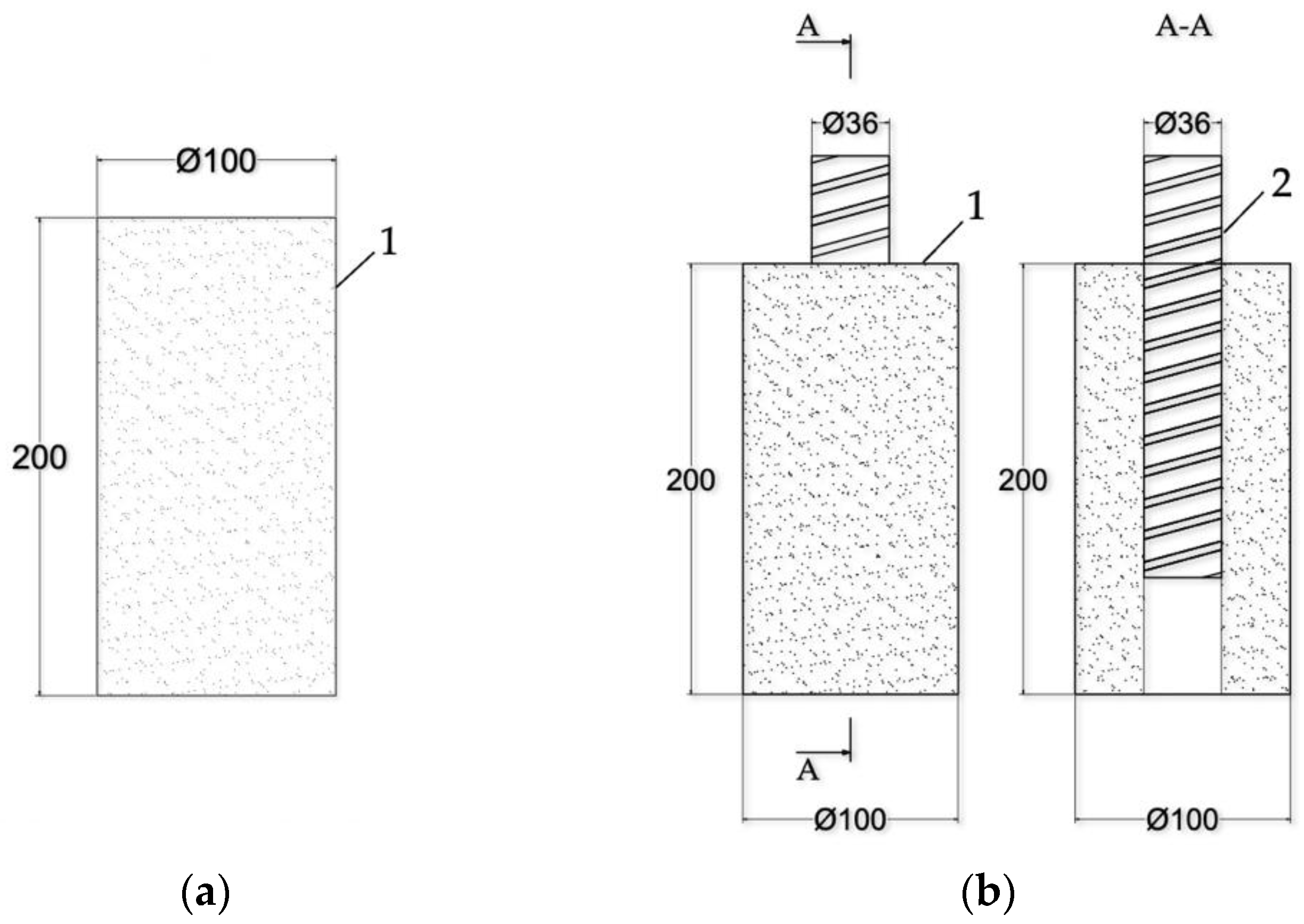
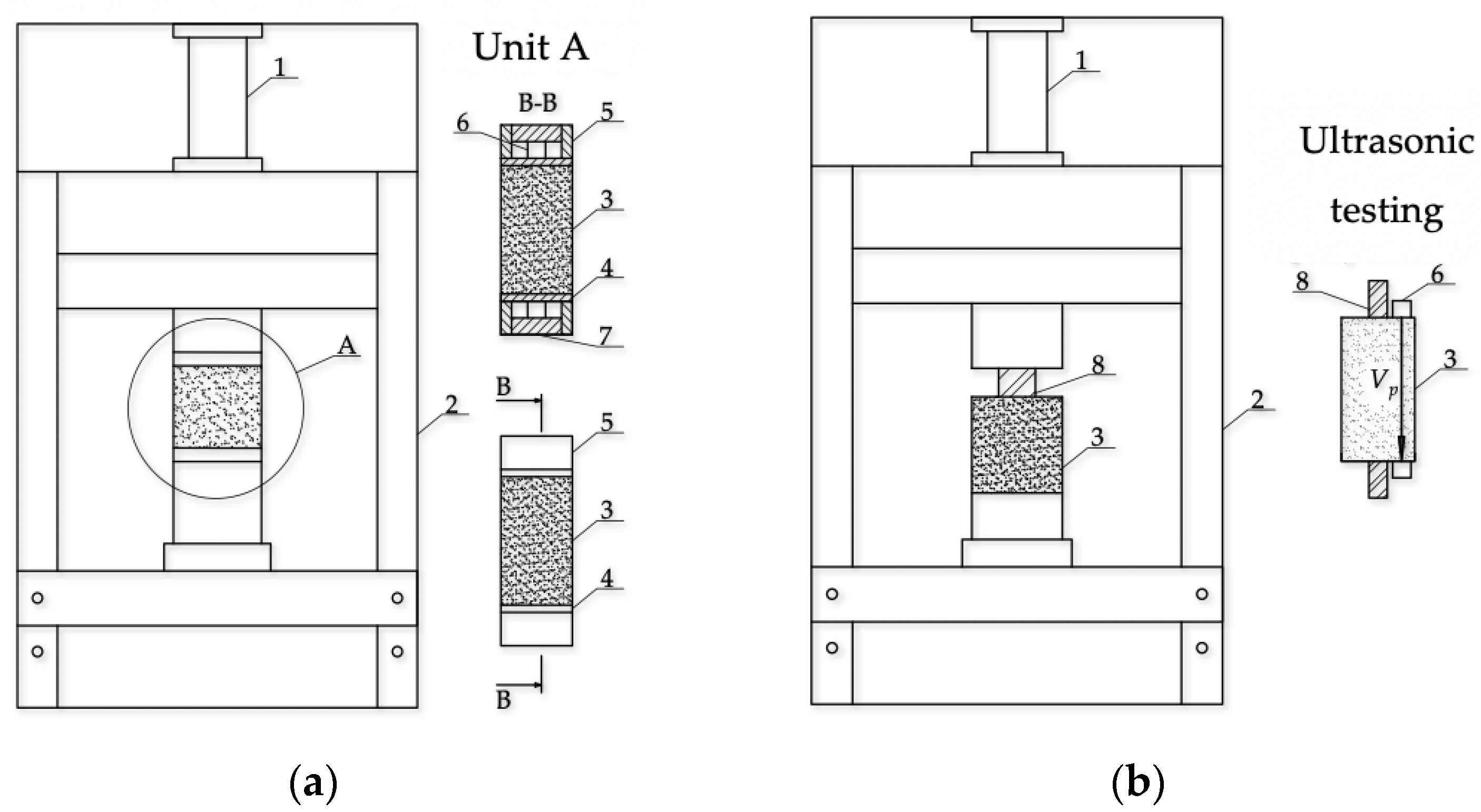

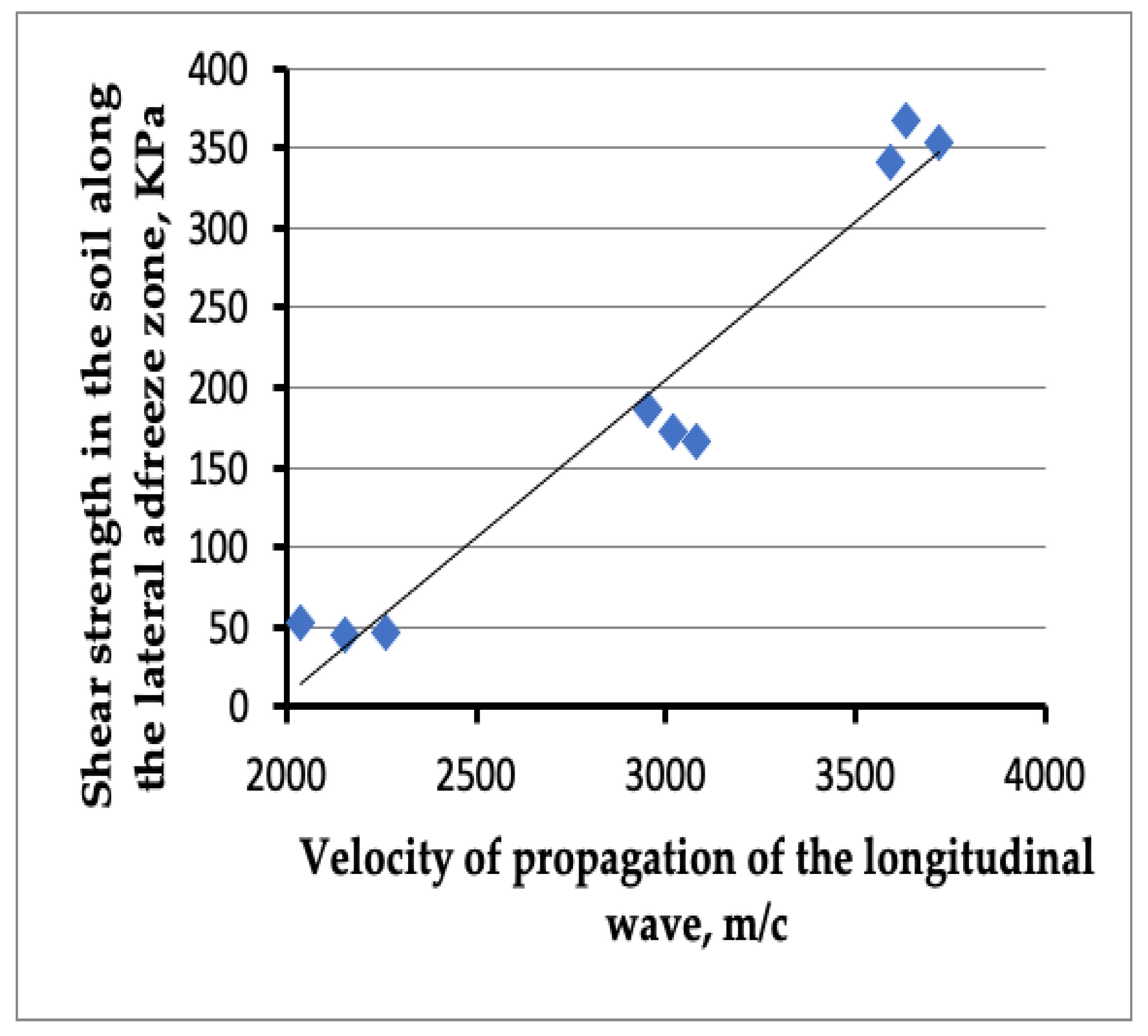
| Model | Parameter | Method |
|---|---|---|
| Mohr–Coulomb | E | Triaxial compression, pressuremeter tests |
| Oedometer tests | ||
| In-plane shear tests | ||
| c | ||
| Hardening Soil | Triaxial compression | |
| Triaxial compression | ||
| Triaxial compression | ||
| In-plane shear tests | ||
| c | ||
| Triaxial compression | ||
| OCR | In-plane shear tests |
| Soil Type | Moisture, % | Density, kg/m3 |
|---|---|---|
| sand | 25 | 1750 |
| Holding Period | Sample No. 1 | Samples No. 2–4 | Sample No. 5 | Samples No. 6–8 | Sample No. 9 | Samples No. 10–12 |
|---|---|---|---|---|---|---|
| T, min | Vp, m/s | , kPa | VP, m/s | , kPa | VP, m/s | , kPa |
| 0 | 3720 | 354 | 3590 | 341 | 3633 | 367 |
| 15 | 3078 | 167 | 2950 | 186 | 3018 | 173 |
| 45 | 2154 | 45 | 2260 | 47 | 2037 | 52 |
| R | 0.97 | 0.99 | 0.96 | |||
| Soil | Method Used to Find E | E by Temperature, MPa | ||
|---|---|---|---|---|
| −10 °C | −3 °C | °C | ||
| Sand | acoustic testing | 9800 | 9300 | 6800 |
| Uniaxial compression | 163 | 150 | 121 | |
| R | 0.98 | |||
Publisher’s Note: MDPI stays neutral with regard to jurisdictional claims in published maps and institutional affiliations. |
© 2022 by the authors. Licensee MDPI, Basel, Switzerland. This article is an open access article distributed under the terms and conditions of the Creative Commons Attribution (CC BY) license (https://creativecommons.org/licenses/by/4.0/).
Share and Cite
Syas’ko, V.; Shikhov, A. Assessing the State of Structural Foundations in Permafrost Regions by Means of Acoustic Testing. Appl. Sci. 2022, 12, 2364. https://doi.org/10.3390/app12052364
Syas’ko V, Shikhov A. Assessing the State of Structural Foundations in Permafrost Regions by Means of Acoustic Testing. Applied Sciences. 2022; 12(5):2364. https://doi.org/10.3390/app12052364
Chicago/Turabian StyleSyas’ko, Vladimir, and Aleksandr Shikhov. 2022. "Assessing the State of Structural Foundations in Permafrost Regions by Means of Acoustic Testing" Applied Sciences 12, no. 5: 2364. https://doi.org/10.3390/app12052364
APA StyleSyas’ko, V., & Shikhov, A. (2022). Assessing the State of Structural Foundations in Permafrost Regions by Means of Acoustic Testing. Applied Sciences, 12(5), 2364. https://doi.org/10.3390/app12052364






